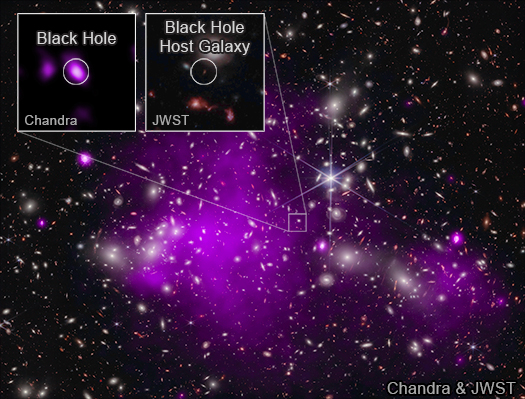The Genesis of Giants: Tracing the Early Development of Supermassive Black Holes
We welcome Orsolya Eszter Kovács, a postdoctoral fellow at Masaryk University, Czechia, as our guest blogger. She spent over two years at the Smithsonian Astrophysical Observatory as a pre-doctoral fellow while working on the PhD she obtained from Eötvös Loránd University, Hungary. She is the first author of a recent paper presenting one of the most distant supermassive black holes ever seen.
In the past six months1 Chandra has unveiled two supermassive black holes remarkably close to their formation epoch, only about 500 million years after the big bang. These findings mark some of the most distant supermassive black holes observed to date.
Supermassive black holes, the largest type of black holes, lurk in the heart of most big galaxies. These cosmic behemoths play a central role in the formation and evolution of their hosting galaxies, exerting influence so significant that they can even suppress star formation.
The origin of these giant black holes is a subject of debate. Do they originate from the collapse of the earliest stellar population, known as Population III stars? Although it seems like an obvious explanation, to reach those immense masses observed in their later stages, these “light black hole seeds” need to be fed with an extreme amount of matter in a relatively brief period (through a process that astronomers call “accretion”). Yet, such a high accretion rate seems improbable as a universal solution, because there are physical limits on how quickly material can fall inwards. The outwards pressure from the intense radiation associated with high accretion can overcome the gravitational forces pulling material inwards, causing the material to be pushed away instead.
Conversely, a “heavy black hole seed” requires a lower rate of accretion, but can only be produced through the direct collapse of massive gas clouds. This process, however, needs to bypass the evolution typically associated with giant gas clouds, where the gas breaks up into small clumps that then form stars, rather than collapsing as one massive cloud to form a black hole.
These two formation scenarios are based on simulations and require observational support. That's where the Chandra X-ray Observatory plays a crucial role. Chandra is the only X-ray telescope capable of observing these sources at such an early cosmic epoch. Supermassive black holes, during periods of active accretion, emit X-ray radiation. This radiation, even at enormous distances, may remain detectable by Chandra thanks to the unique combination of its high resolution, large collecting area, and sensitivity.
Both recent very distant supermassive black hole detections are the outcome of a novel synergy between Chandra and the James Webb Space Telescope (JWST). Additionally, the giant galaxy cluster Abell 2744 acts as a gravitational lens, providing an extra boost for the telescopes. Behind this lensing cluster, JWST discovered at least about 20 extremely distant galaxies, seen at times less than 550 million years after the big bang.
The quest of our research team, led by Ákos Bogdán of the Center for Astrophysics | Harvard & Smithsonian (CfA), was to identify X-ray signatures of supermassive black holes within these galaxies. For this, we used deep observations taken by Chandra between 2022 and 2024. It was an ambitious, carefully planned, and ultimately successful project, leveraging the unique capabilities of Chandra to its fullest extent.
Before completing its observations of Abell 2744 and the distant Universe magnified behind it, Chandra already detected the central black hole of the distant galaxy, UHZ1, seen only 470 million years after the big bang. This discovery could stand as one of the most significant X-ray findings in recent years.

UHZ1 and Abell 2744
Credit: X-ray: NASA/CXC/SAO/Ákos Bogdán; Infrared: NASA/ESA/CSA/STScI;
Image Processing: NASA/CXC/SAO/L. Frattare & K. Arcand
As Chandra continued its mission and collected more and more data of the Abell 2744 field, another supermassive black hole candidate began to emerge in the images: this one is at the heart of a distant galaxy, GHZ9, seen only about 450 million years after the big bang. It's worth noting that this second detection further strengthens the validity of the initial discovery: with two independent detections, the likelihood of the X-ray emission being a false detection diminishes significantly.
What insights do these detections provide regarding the origin of supermassive black holes? Armed with the Chandra data, we were able to estimate the mass of these giant black holes at the earliest stages of their formation known to date. Both detections give consistent results: roughly 500 million years after the big bang, these black holes may have already reached masses approaching 10 to 100 million times the mass of the Sun. If we assume that they did not accrete at their full capacity, this mass could go even higher. Accordingly, we conclude that the “heavy seed” scenario was in effect when forming these two supermassive black holes.
Returning to simulations, this discovery is quite surprising, as we did not expect the heavy seed scenario to be this effective, producing two supermassive black holes within the same field. These two detections hint that not only one, but multiple channels for heavy seed formation may operate simultaneously in the early Universe. In fact, the “light seed” scenario may also play a role in forming supermassive black holes in parallel with the heavy seed formation.
The next question arises: are these two extremely distant supermassive black holes typical? Chandra undoubtedly has the potential to address this interesting question. Deep observations of other galaxy clusters will pave the way for the discovery of more sources, expanding the palette of extremely distant black holes. As you read this post, Chandra has already begun capturing images of our next target, the galaxy cluster Abell 370.
1The first result was published in Nature Astronomy earlier this year and was the subject of a Chandra press release last November, and the second result was published in the April 20th issue of The Astrophysical Journal Letters.
Category:
- Log in to post comments

